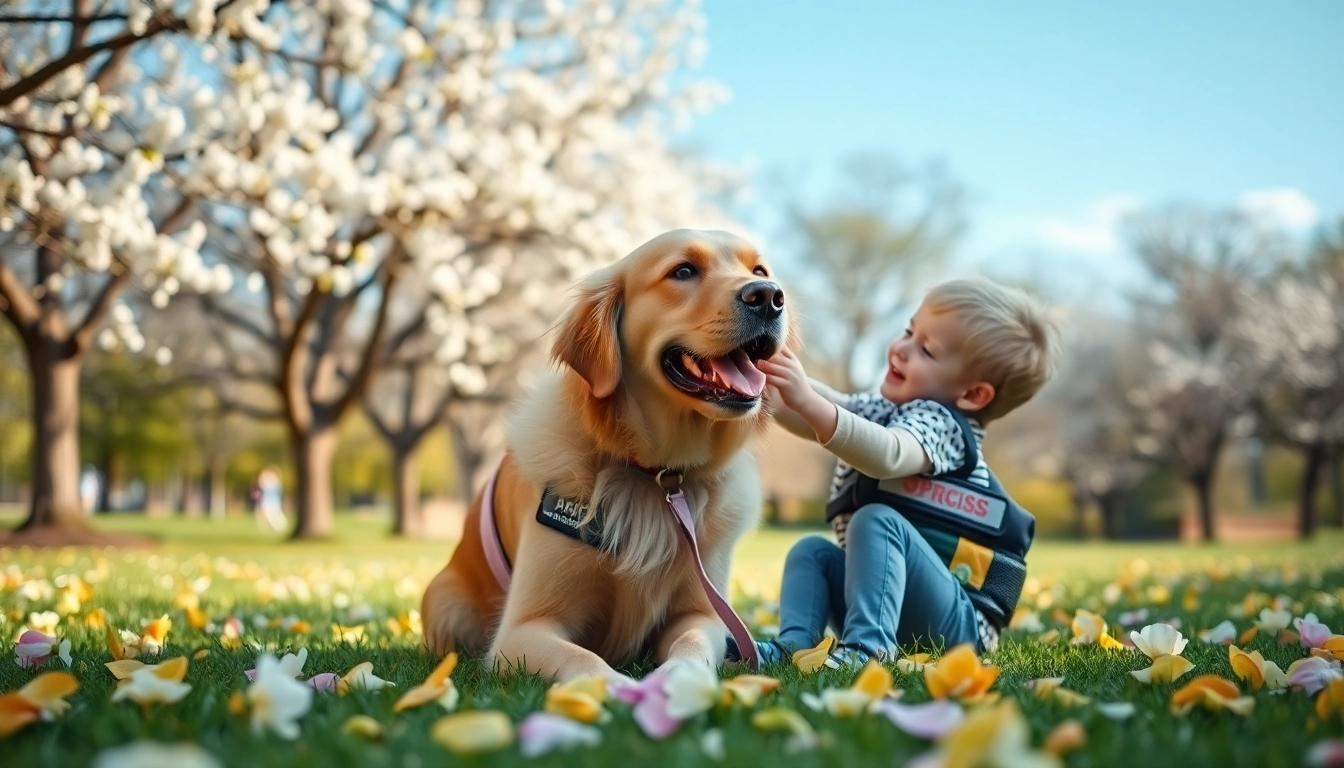Understanding Autism Dogs and Their Role in Therapy
Autism dogs have emerged as vital companions and support mechanisms for individuals with autism spectrum disorder (ASD). These dogs are specially trained to assist autistic individuals and their families by providing emotional support, facilitating social interactions, and sometimes offering physical assistance. They are not just pets but are integral members of the support network for those with autism. The role of autism dogs extends beyond companionship; they are equipped with specific skills that enhance the quality of life and aid in managing daily challenges associated with autism. For those considering an autism dog, there are various resources available, including autism dogs for sale.
1. What Are Autism Dogs?
An autism assistance dog, also referred to as an autism service dog, is a specially trained companion that helps individuals navigate the complexities of daily living with autism. These dogs are trained to respond to particular behaviors associated with autism and provide various forms of assistance. Typically, autism dogs are paired with children or adults diagnosed with autism, though they can be beneficial for family members as well. Their primary objective is to promote independence and enhance the well-being of those with ASD.
2. Benefits of Autism Dogs for Individuals with Autism
The benefits of having an autism dog are extensive and varied, impacting multiple facets of an individual’s life. Some of the key advantages include:
- Emotional Support: Autism dogs provide unwavering companionship, helping reduce feelings of loneliness and anxiety.
- Social Skills Enhancement: These dogs can serve as social facilitators, helping individuals with autism engage in interactions with peers and the community.
- Improved Safety: Autism dogs are trained to perform specific tasks that enhance safety, such as tethering to a child during walks or alerting caregivers if a child wanders off.
- Calming Presence: The presence of a dog can trigger the release of calming hormones in both children and adults, promoting a sense of comfort.
- Structured Routine: Caring for a dog instills responsibility and structure in the daily life of an autistic individual.
3. Different Types of Autism Dogs
Autism dogs can be categorized based on their training and the specific needs they address. Some of the common types include:
- Mobility Assistance Dogs: Trained to help with physical mobility and provide support during walks.
- Seizure Response Dogs: Equipped to alert caregivers during a seizure or a medical episode, often related to additional conditions.
- Emotional Support Dogs: Focused mainly on providing emotional comfort and companionship.
- Therapy Dogs: Work with specialists to facilitate therapy sessions, encouraging social interaction and communication.
How Autism Dogs Are Trained for Effective Support
1. Training Processes for Autism Dogs
The training of autism dogs is a critical aspect of their effectiveness. Each dog goes through specialized training that may include:
- Basic Obedience Training: All assistance dogs must learn commands such as sit, stay, and come.
- Behavioral Training: Focuses on specific autism-related behaviors like grounding techniques, staying close to an individual, and behavioral interruptions.
- Public Access Training: Prepares the dog for various environments to ensure they remain calm in public settings.
- Task Training: Teaches the dog to perform specific tasks, such as alerting when a child is about to wander off.
2. Key Skills and Tasks of Autism Dogs
The skills and tasks autism dogs learn are centered around providing support and mitigating the challenges faced by their handlers. Some essential skills include:
- Touch and Tactile Response: Dogs can be trained to provide pressure or tactile stimulation to help alleviate anxiety.
- Interrupting Meltdowns: Training involves teaching the dog to intervene when a child is overwhelmed, redirecting their attention.
- Grounding Techniques: Dogs may be trained to sit or lie next to an individual experiencing sensory overload, providing a calming presence.
- Alerting Caregivers: This can include barking or nudging to alert a caregiver if a child wanders off or encounters a potentially harmful situation.
3. Choosing the Right Training Program
When seeking an autism dog, it’s crucial to select a reputable training program that adheres to recognized standards. Factors to consider include:
- Certification: Ensure the organization is accredited and their trainers are certified.
- Customized Training: Find programs that tailor their training to meet the specific needs of autism assistance.
- Follow-Up Support: Look for programs that offer ongoing support after placement, ensuring the partnership between dog and handler remains effective.
Finding the Right Autism Dog for Your Needs
1. Application Processes for Autism Dogs
The application process for obtaining an autism dog can vary by organization but generally includes the following steps:
- Preliminary Application: Complete a form detailing the needs of the individual expected to work with the dog.
- Interview and Assessment: Many organizations conduct interviews to assess the fit between the family and potential dogs.
- Home Visit: A home visit may occur to determine the suitability of the home environment for an autism dog.
- Placement: Once approved, the family will be matched with a dog based on the previously assessed needs.
2. Selecting the Right Breed for Children
Choosing the right breed for a child with autism is crucial for ensuring a productive partnership. Some breeds are more suited for service work due to their temperament, size, and trainability. Popular breeds for autism assistance include:
- Labrador Retriever: Known for their gentle nature and eagerness to please.
- Golden Retriever: Friendly and affectionate, making them great companions for children.
- Poodle: Highly intelligent and trainable, suitable for various tasks.
- Bulldog: Calm and patient, which can ease anxiety in children.
3. Assessing the Compatibility of Autism Dogs with Your Family
Before bringing an autism dog into your home, it’s important to assess compatibility. Considerations include:
- Energy Levels: Match the dog’s activity level with the child’s. Low-energy dogs may be better for children who need a calming presence.
- Temperament: The dog should have a calm demeanor to help soothe anxious children.
- Family Dynamics: Involve family members in the selection process to ensure everyone is prepared for the new addition.
Real-Life Stories: Impact of Autism Dogs on Families
1. Heartwarming Testimonials from Families
Families sharing their experiences with autism dogs often recount transformational stories, illustrating the deep bond that develops between children and their canine companions. These personal narratives emphasize the changes in social dynamics, emotional well-being, and overall family harmony. Testimonials reveal how the presence of an autism dog mitigated challenging behaviors, eased anxiety, and fostered friendships.
2. Case Studies: Autism Dogs Making a Difference
Various documented case studies highlight specific instances where autism dogs significantly impacted individual lives. For example, a child who previously struggled with anxiety and sensory overload found a stable connection with an autism dog, leading to improved confidence and social interactions. Another family reported a drastic reduction in meltdowns thanks to the dog’s calming influence. Each case study provides compelling evidence of the profound benefits that these dogs can bring to their handlers.
3. Long-term Effects of Autism Dogs on Social Interaction
The long-term effects of having an autism dog are often profound, promoting not only a bond with the dog but also enhancing engagement with peers. As children grow more comfortable interacting with their autism dogs, they typically demonstrate improved social skills, making it easier for them to connect with others and participate in community activities. The reciprocal relationship between the dog and child often leads to lifelong friendships and enriched lives.
Resources and Support for Autism Dog Programs
1. National Organizations Supporting Autism Dogs
There are various national organizations dedicated to supporting those in search of autism dogs. These organizations not only provide training and placement but also offer resources for families need assistance in finding the right support system.
2. Local Resources for Autism Dog Training
Local resources, including community training programs and workshops, can provide direct support and guidance. Many local trainers specialize in autism assistance, giving families access to tailored training to meet their needs.
3. Community Networks for Families with Autism Dogs
Community networks play a pivotal role in connecting families who have autism dogs. These networks foster relationships among families, offer shared experiences, and provide educational resources to enhance the bonding experience between families and their dogs.



